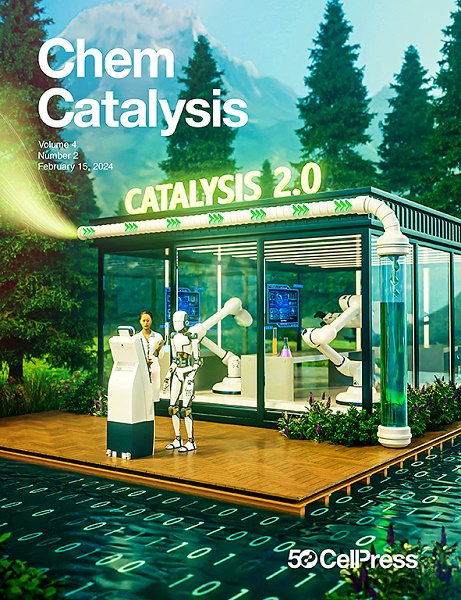Interfacial structure engineering enhances photo-thermal CO2 hydrogenation over Ni-CeO2 nanocomposites
IF 11.6
Q1 CHEMISTRY, PHYSICAL
引用次数: 0
Abstract
Metal-support interfaces play pivotal roles in governing the catalytic behaviors in heterogeneous catalysts, yet their optimized construction remains a formidable challenge. Here, we delve into the role of nickel-ceria interfaces in enhancing photo-thermal CO2 hydrogenation by designing a series of Ni/CeO2 composite catalysts with distinct interfacial features. The one with a well-defined nickel-ceria interface, achieved through lattice matching, demonstrates an exceptional CH4 production rate of 477.3 mmol gcat−1 h−1 (99.7% selectivity, 89.4% CO2 conversion) at 250°C under ambient pressure and light irradiation (200–1,100 nm, 2740 mW cm−2). This remarkable performance is credited to the distinctive metal-support interaction and efficient charge transfer at the interface. In contrast, catalysts lacking lattice-matched interfaces or featuring encapsulated nickel nanoparticles show inferior activity due to inhibited charge transfer and restricted access to active sites. These findings underscore the importance of interface engineering in optimizing photo-thermal catalysts for CO2 hydrogenation.

界面结构工程增强Ni-CeO2纳米复合材料的光热CO2加氢作用
金属支撑界面在控制非均相催化剂的催化行为中起着关键作用,但其优化结构仍然是一个艰巨的挑战。本文通过设计一系列具有不同界面特征的Ni/CeO2复合催化剂,深入研究了镍-铈界面在促进光热CO2加氢中的作用。在250°C的环境压力和光照(200 - 1100 nm, 2740 mW cm - 2)下,具有良好的镍-铈界面的纳米粒子的CH4产率为477.3 mmol gcat−1 h−1(选择性99.7%,CO2转化率89.4%)。这种卓越的性能归功于独特的金属-支撑相互作用和界面上有效的电荷传递。相比之下,缺乏晶格匹配界面或封装镍纳米颗粒的催化剂由于抑制电荷转移和限制活性位点的进入而表现出较差的活性。这些发现强调了界面工程在优化CO2加氢光热催化剂中的重要性。
本文章由计算机程序翻译,如有差异,请以英文原文为准。
求助全文
约1分钟内获得全文
求助全文
来源期刊
CiteScore
10.50
自引率
6.40%
发文量
0
期刊介绍:
Chem Catalysis is a monthly journal that publishes innovative research on fundamental and applied catalysis, providing a platform for researchers across chemistry, chemical engineering, and related fields. It serves as a premier resource for scientists and engineers in academia and industry, covering heterogeneous, homogeneous, and biocatalysis. Emphasizing transformative methods and technologies, the journal aims to advance understanding, introduce novel catalysts, and connect fundamental insights to real-world applications for societal benefit.

 求助内容:
求助内容: 应助结果提醒方式:
应助结果提醒方式:


